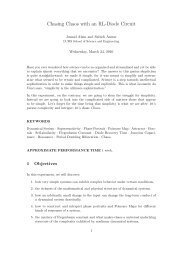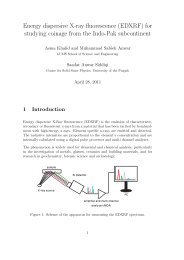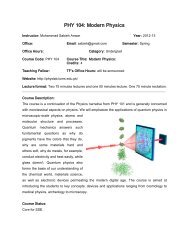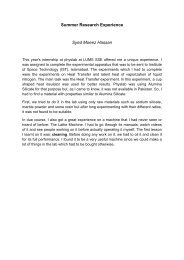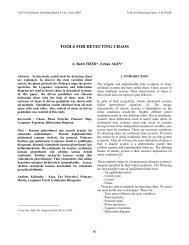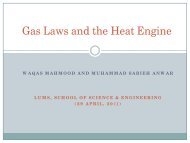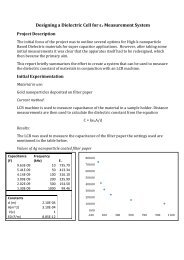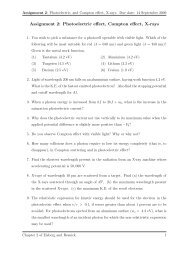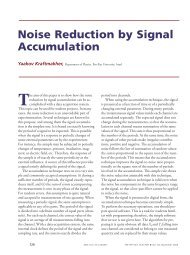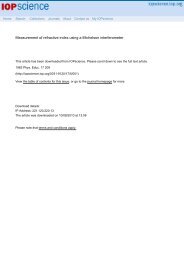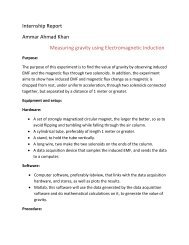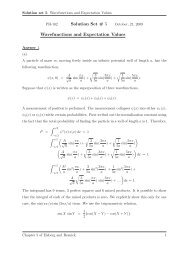Vibrations on a String and Resonance - Experimental Physics
Vibrations on a String and Resonance - Experimental Physics
Vibrations on a String and Resonance - Experimental Physics
Create successful ePaper yourself
Turn your PDF publications into a flip-book with our unique Google optimized e-Paper software.
<str<strong>on</strong>g>Vibrati<strong>on</strong>s</str<strong>on</strong>g> <strong>on</strong> a <strong>String</strong> <strong>and</strong> Res<strong>on</strong>anceUmer Hassan <strong>and</strong> Muhammad Sabieh AnwarLUMS School of Science <strong>and</strong> EngineeringSeptember 7, 2010How does our radio tune into different channels? Can a music maestro shatter a crystal glass bybeating the tabla with a particular frequency <strong>and</strong> pitch? How does our ear distinguish betweent<strong>on</strong>es in the multitude of sounds we hear every day? The answer to all of these questi<strong>on</strong>s liesin underst<strong>and</strong>ing the c<strong>on</strong>cept of res<strong>on</strong>ance. The idea was discovered by Galileo Galilei with hisinvestigati<strong>on</strong>s of pendulums beginning in 1602. The present experiment gives you an introducti<strong>on</strong>to the phenomen<strong>on</strong> of res<strong>on</strong>ance, <strong>and</strong> the frequencies at which it occurs by visualizing the stati<strong>on</strong>arywaves formed <strong>on</strong> a vibrating string. We hope you will enjoy this exercise of exciting <strong>and</strong> detectingst<strong>and</strong>ing waves <strong>on</strong> a string.KEYWORDSTransverse wave · L<strong>on</strong>gitudinal wave · Wave interference · Res<strong>on</strong>ance · stati<strong>on</strong>ary waves · Circularmodes · normal modesAPPROXIMATE PERFORMANCE TIME 4 hours.1 C<strong>on</strong>ceptual ObjectivesIn this experiment we will learn,1. the c<strong>on</strong>cept of wave,2. the difference between transverse <strong>and</strong> l<strong>on</strong>gitudinal waves,3. the phenomen<strong>on</strong> of wave interference,4. the c<strong>on</strong>cept of wave vector <strong>and</strong> wave number,5. derivati<strong>on</strong> of the wave speed, <strong>and</strong>6. the formati<strong>on</strong> of stati<strong>on</strong>ary waves.2 <strong>Experimental</strong> ObjectivesThe experimental objectives for the experiment include,1. exciting <strong>and</strong> detecting st<strong>and</strong>ing waves <strong>on</strong> a string,2. being able to identify where res<strong>on</strong>ance occurs,3. distinguishing linear from n<strong>on</strong>linear behaviors, <strong>and</strong>1
YDirecti<strong>on</strong> of Propagati<strong>on</strong>vMoti<strong>on</strong> of WaveParticleFigure 2: Illustrati<strong>on</strong> of particle moti<strong>on</strong> w.r.t to wave propagati<strong>on</strong> in a transverse wave.3.3 Sinusoidal or harm<strong>on</strong>ic wavesThe sine wave is a mathematical functi<strong>on</strong> that describes a smooth repetitive oscillati<strong>on</strong>. Mathematically,it can be expressed as,y(t) = Asin(ωt + ϕ), (1)where, A the amplitude, is the peak deviati<strong>on</strong> of the functi<strong>on</strong> from its center positi<strong>on</strong>. ω, the angularfrequency, specifies how many oscillati<strong>on</strong>s occur in a unit time interval, in radians per sec<strong>on</strong>d. It isgiven by ω = 2πf , f being the frequency of the wave. ϕ is the phase, specifying where in its cyclethe oscillati<strong>on</strong> begins at t = 0. These c<strong>on</strong>cepts are illustrated in Figure 3.Oscillati<strong>on</strong>s dominate in real life All electromagnetic energy, including visible light, microwaves, radiowaves, <strong>and</strong> X-rays, can be represented by a sine wave or a combinati<strong>on</strong> of sine waves. At the lowestlevel, even matter oscillates like a wave. This is the realm of quantum physics. Other examplesinclude ocean waves, sound waves, <strong>and</strong> tides. Given the ubiquitous nature of waves, the currentexperiment sets to reveal some interesting properties. However, some more background theory isrequired before we can start our experiment.4 Wave Interference <strong>and</strong> Res<strong>on</strong>ance4.1 Interference of wavesInterference is the phenomen<strong>on</strong> occurring when two waves meet while traveling al<strong>on</strong>g the samemedium. C<strong>on</strong>structive interference is a type of interference which occurs at any locati<strong>on</strong> al<strong>on</strong>gthe medium where the two interfering waves have a displacement in the same directi<strong>on</strong>. In otherwords, when the crest or trough of <strong>on</strong>e wave passes through, or is super positi<strong>on</strong>ed up<strong>on</strong>, the crestor trough respectively of another wave, the waves c<strong>on</strong>structively interfere. When waves interfere,amplitudes add. Figure 4 shows the two waves of different amplitudes c<strong>on</strong>structively interfering togive a resulting wave of increased amplitude.Destructive interference is the type of interference which occurs at any locati<strong>on</strong> al<strong>on</strong>g the mediumwhere the two interfering waves have a displacement in the opposite directi<strong>on</strong>. When the crest of<strong>on</strong>e wave passes through, or is super positi<strong>on</strong>ed up<strong>on</strong>, the trough of another wave, we say thatthe waves destructively interfere. We often say that when waves interfere, amplitudes add. Duringdestructive interference, since the positive amplitudes from <strong>on</strong>e crest are added to the negativeamplitudes from the other trough, this additi<strong>on</strong> can look like a subtracti<strong>on</strong>. Refer to Figure 5 for adem<strong>on</strong>strati<strong>on</strong> of this c<strong>on</strong>cept.If the phase difference is close to 180 ◦ , the resultant amplitude is nearly zero. When ϕ is exactly180 ◦ , the crest of <strong>on</strong>e wave falls exactly <strong>on</strong> the valley of the other. The resultant amplitude is zero,corresp<strong>on</strong>ding to total destructive interference.3
(a)Amplitude1086420−2−4−6−8−100 2 4 6 8 1010864Angular frequency, w (rad/sec)(b)Amplitude20−2−4−6−8−100 1 2 3 4 5 61086Angular frequency, w (rad/sec)(c)Amplitude420−2−4−6−8−100 1 2 3 4 5 6Angular frequency, w (rad/sec)Figure 3: Illustrati<strong>on</strong> of variati<strong>on</strong> of amplitude, frequency <strong>and</strong> phase of harm<strong>on</strong>ic waves, (a) amplitudeof <strong>on</strong>e wave is twice the other, (b) frequency of <strong>on</strong>e wave is twice the other, <strong>and</strong> (c) <strong>on</strong>e wavehas a phase difference of π 2with the other.⋆ Q 1. Two waves travel in the same directi<strong>on</strong> <strong>and</strong> interfere. Both have the same wavelength,wave speed <strong>and</strong> an amplitude of 10 mm. There is a phase difference of 110 ◦ between them.(a) What is the resulting amplitude due to wave interference? (b) How much should the phasedifference change so that the resultant wave has an amplitude of 5 mm?4.2 St<strong>and</strong>ing or stati<strong>on</strong>ary wavesSt<strong>and</strong>ing waves are formed by the interference of two harm<strong>on</strong>ic waves of the same amplitude<strong>and</strong> frequency (<strong>and</strong> therefore same wavelength), but traveling in opposite directi<strong>on</strong>s. Due to theinterference of the two waves, there are certain points called nodes at which the total wave is zeroat all times. The distance between two c<strong>on</strong>secutive nodes is exactly half the wavelength. The points4
BoundariesAntinodeNodeλ\2Figure 6: St<strong>and</strong>ing wave.particle of the free end. Since the rope <strong>and</strong> boundary are no l<strong>on</strong>ger attached <strong>and</strong> interc<strong>on</strong>nected,they will slide past each other. So when a crest reaches the free end, the last particle of the wavereceives the same upward displacement; <strong>on</strong>ly now there is no adjoining particle to pull downwardup<strong>on</strong> the last particle of the wave to cause it to be inverted. The result is that the reflected wave isnot inverted. When an upward displaced wave is incident up<strong>on</strong> a free end, it returns as an upwarddisplaced wave after reflecti<strong>on</strong> <strong>and</strong> vive versa. Inversi<strong>on</strong> is not observed in free end reflecti<strong>on</strong>, asshown in Figure 7.TransmittedWaveFreeBoundaryReflectedWaveFigure 7: Reflected wave from free end doesn’t gets inverted.4.3.2 Reflecti<strong>on</strong> from a fixed endIf a boundary is stati<strong>on</strong>ary i.e. not vibrating but fixed <strong>and</strong> a wave is traveling towards it, <strong>on</strong> reachingthe boundary, two things occur.1. A porti<strong>on</strong> of the energy carried by the pulse is reflected <strong>and</strong> returns.2. A porti<strong>on</strong> of the energy carried by the pulse is transmitted to the boundary, causing it tovibrate. But these vibrati<strong>on</strong>s are negligible, may c<strong>on</strong>tribute to sound or heat <strong>and</strong> are notdiscussed here.The reflected wave gets inverted. That is, if an upward displaced wave is incident towards a fixed endboundary, it will reflect <strong>and</strong> return as a downward displaced wave <strong>and</strong> vice versa, as shown in Figure 8.6
FixedBoundaryTransmittedWaveReflectedWaveFigure 8: Inversi<strong>on</strong> take place from the fixed boundary.If there is c<strong>on</strong>tinuous generati<strong>on</strong> of transverse waves from <strong>on</strong>e end <strong>and</strong> a transmitted wave getsinverted after being reflected from other end which is fixed, the wave interference took place <strong>and</strong>we get a stati<strong>on</strong>ary wave as depicted in Figure 8. In our experiment we shall be forming st<strong>and</strong>ingwaves by c<strong>on</strong>tinuously generating waves at <strong>on</strong>e end <strong>and</strong> by keeping the other end fixed.4.4 Res<strong>on</strong>anceThe frequencies at which we get the stati<strong>on</strong>ary waves are the natural frequencies of the oscillatingsystem (in our case vibrating string). If we drive <strong>on</strong>e end of the string <strong>and</strong> when the frequency ofthe driving force matches with the natural frequency of the string, st<strong>and</strong>ing wave is produced <strong>and</strong>the string begins to move at large amplitude. This phenomen<strong>on</strong> is called as res<strong>on</strong>ance.5 Wave Speed5.1 Basic definiti<strong>on</strong>sThe wavelength λ is the distance between two c<strong>on</strong>secutive crests or troughs in case of transversewave. The period T of the wave is the time required for any particular point <strong>on</strong> a wave to undergo<strong>on</strong>e complete cycle of transverse or l<strong>on</strong>gitudinal moti<strong>on</strong>. The frequency f is the number of thewave cycles completed in <strong>on</strong>e sec<strong>on</strong>d. The wave number k is the inverse of the wavelength <strong>and</strong> isexpressed as,Likewise, the angular frequency ω is,k = 2π λ . (2)ω = 2πT= 2πf . (3)The length L of the vibrating string in which st<strong>and</strong>ing waves are developed can be expressed asintegral multiples of half of the wavelength, i.e.,where n = 1,2,3,. . . is an integer. So, λ can be written as,L = nλ 2 , (4)λ = 2L n . (5)7
Substituting the value of λ into Equati<strong>on</strong> 2, we get,k = nπ L . (6)The wave speed v can be written as,v = f λ = f 2π k = ω k . (7)5.2 Speed of wave <strong>on</strong> a string subject to tensi<strong>on</strong>The speed of the waves <strong>on</strong> a string depends up<strong>on</strong> the mass of the string element <strong>and</strong> the tensi<strong>on</strong>T under which the string is stretched. The mass of the string element can be expressed in term ofthe linear mass density µ, which is the mass per unit length.vδlTTθRoFigure 9: A small porti<strong>on</strong> of string under the acti<strong>on</strong> of forces.Let’s c<strong>on</strong>sider a small secti<strong>on</strong> of string of length δl as shown in Figure 9. Here v represents thewave speed <strong>and</strong> the directi<strong>on</strong> in which the wave is traveling is identified by the arrow. The elementis part of an arc that is part of an an approximate circle of radius R. The mass δm of this elementis µδl. The tensi<strong>on</strong> T in the string is the tangential pull at each end of the segment. The horiz<strong>on</strong>talcomp<strong>on</strong>ents cancel since they are equal <strong>and</strong> opposite to each other. However, each of the verticalcomp<strong>on</strong>ents is equal to T sinθ, so the the total vertical force is 2T sinθ. Since θ is very small, wecan approximate sinθ ≈ θ. C<strong>on</strong>sidering the triangle shown in the Figure 9, we find that, 2θ = δl \R.So, the net force F acting <strong>on</strong> the string element can be written as,F = 2T sinθ ≈ 2T θ = T δlR . (8)This is the force which is supplying the centripetal accelerati<strong>on</strong> of the string particles towards O.The centripetal force F c acting <strong>on</strong> the mass δm = µδl moving in a circle of radius R with linearspeed v is,F c = δmv 2(9)REquating the two forces, we get,T δlR = δmv 2(10)R√Tv =µ . (11)8
Thus, the wave speed depends up<strong>on</strong> the tensi<strong>on</strong> <strong>and</strong> the linear mass density of the string.⋆ Q 2. Show that Equati<strong>on</strong> 11 is dimensi<strong>on</strong>ally correct.⋆ Q 3. A transverse sinusoidal wave is generated at <strong>on</strong>e end of l<strong>on</strong>g horiz<strong>on</strong>tal string by a barthat moves the end up <strong>and</strong> down through a distance of 1.5 cm.The moti<strong>on</strong> is repeated at a rate of130 times per sec<strong>on</strong>d. If a string has a linear density of 0.251 kg/m <strong>and</strong> is kept under a tensi<strong>on</strong> of100 N, find the amplitude, frequency, speed <strong>and</strong> wavelength of the wave moti<strong>on</strong>.6 <strong>Experimental</strong> setupC<strong>on</strong>sider a stretched string that is fixed from <strong>on</strong>e end through a rigid support, is strung over a pulley<strong>and</strong> a weight W is hung at the other end. The string can be set under vibrati<strong>on</strong>s using a mechanicaloscillator, which in our case is a speaker (woofer) fed with a signal generator. Let L be the lengthbetween the wedge <strong>and</strong> the oscillator as shown in Figure 10. If st<strong>and</strong>ing waves are established<strong>on</strong> the string, then the wave vectors can be written as,k n = nπ L, n = 1, 2, 3, . . . (12)LRigidSupportPulleyWedgeMechanicalVibratorWFigure 10: The experimental setup. A string is stretched between a rigid support <strong>and</strong> a mechanicalvibrator, which in our case, is a speaker. Tensi<strong>on</strong> in the string is introduced by a hanging mass.The relati<strong>on</strong> between the angular frequency with the wave vector, is called the dispersi<strong>on</strong> relati<strong>on</strong><strong>and</strong> depends up<strong>on</strong> the effective length <strong>and</strong> the tensi<strong>on</strong>. It can be derived as follows,Equating Equati<strong>on</strong>s 11 <strong>and</strong> 7, we obtain,√ωk = Tµ(13)Hence, for the bare string, the dispersi<strong>on</strong> relati<strong>on</strong> is given by,√ √Tω(k) =µ × k = n Tµ × π L . (14)The equati<strong>on</strong> clearly shows that that the frequency modes ω(k) are directly proporti<strong>on</strong>al to thewave vector. Thus the dispersi<strong>on</strong> relati<strong>on</strong> for the string is linear.A normal mode of an oscillating system is a pattern of moti<strong>on</strong> in which all parts of the systemmove sinusoidally with the same frequency <strong>and</strong> in phase. The frequencies of the normal modes areknown as its natural frequencies or res<strong>on</strong>ant frequencies. A normal mode is characterized by a modenumber n, <strong>and</strong> is numbered according to the number of half waves in the vibrati<strong>on</strong>al pattern. If the9
vibrati<strong>on</strong>al pattern has <strong>on</strong>e stati<strong>on</strong>ary wave, the mode number is 1, for two stati<strong>on</strong>ary waves, themode number is 2 <strong>and</strong> so <strong>on</strong>.Our goal in this experiment is to locate the normal modes of the vibrating string. We shall observethe formati<strong>on</strong> of stati<strong>on</strong>ary waves <strong>on</strong> a vibrating string at res<strong>on</strong>ance. The gist of the experimentis that the frequency ω will be varied until a pattern of st<strong>and</strong>ing waves is observed. When thisc<strong>on</strong>diti<strong>on</strong> is achieved, there will be an integer number of half-wavelengths formed <strong>on</strong> the string,which will be vibrating with a large amplitude. This is precisely what a normal mode is! We haveexcited a normal mode. The driving frequency is in res<strong>on</strong>ance with a normal mode frequency. Wewill note down the frequency ω <strong>and</strong> the number n of half-wavelengths <strong>and</strong> will verify the relati<strong>on</strong>shipgiven in Equati<strong>on</strong> (14).6.1 Procedure⋆ Q 4. After receiving all the equipment, set up the apparatus according to the illustrati<strong>on</strong> inFigure 10.⋆ Q 5. Carry out the following experimental procedure to find the dispersi<strong>on</strong> relati<strong>on</strong> for thestring.1. Determine the value of µ of the string. (The density of the string is 8000 kg/m 3 ). What isthe uncertainty in the value?2. Place a driver at any place at the string such that the effective length is 1.5m.3. Attach 1 kg weight with the other end of the string.4. Now sweep the frequency slowly using the signal generator <strong>and</strong> find the frequencies at whichthe res<strong>on</strong>ance occurs, i.e., where you observe the maximum amplitude st<strong>and</strong>ing waves. Startwith 1 Hz <strong>and</strong> increase the frequency with an increment of 0.1 Hz.5. Note down all the frequencies <strong>and</strong> plot a graph between frequency <strong>and</strong> the number of themode n. This is the desired dispersi<strong>on</strong> relati<strong>on</strong>.⋆ Q 6. Curve fit the data to Equati<strong>on</strong> 14. What is your calculated value of T /µ?⋆ Q 7. Change the string tensi<strong>on</strong> using different weights (1.2 kg <strong>and</strong> 1.4 kg) <strong>and</strong> plot thedispersi<strong>on</strong> relati<strong>on</strong> for each case. Preferably, plot all your results with varying weight <strong>on</strong> thesame graph. Describe your observati<strong>on</strong>s.⋆ Q 8. Change the string length (1 m <strong>and</strong> 1.25 m) by changing the driver positi<strong>on</strong> <strong>and</strong> plot thedispersi<strong>on</strong> relati<strong>on</strong> for each case. Preferably, plot all your results with varying lengths <strong>on</strong> thesame graph. You should be able to describe your observati<strong>on</strong>s.6.2 Circular modes in the vibrating stringThe string is being driven in a vertical directi<strong>on</strong> <strong>and</strong> therefore is expected to vibrate in the verticalplane <strong>on</strong>ly. At or near res<strong>on</strong>ance the string has vertical as well as horiz<strong>on</strong>tal oscillati<strong>on</strong>s. This canbe easily visualized by having a side <strong>and</strong> top view of vibrating string. At this point each elementof the string is moving in a circle about the equilibrium positi<strong>on</strong> of the string. These oscillatorypatterns are called circular modes [3].⋆ Q 9. Is there any change in the string tensi<strong>on</strong> as the string vibrates?10
⋆ Q 10. Can you identify the reas<strong>on</strong> for occurrence of these circular modes?⋆ Q 11. Observe what is the effect of decreasing the oscillator’s amplitude <strong>on</strong> the circularmodes?6.3 Res<strong>on</strong>ance modes <strong>on</strong> a loaded string6.3.1 TheoryThe atoms in a crystalline structure are not at rest, they vibrates about their mean positi<strong>on</strong>s underthe influence of some energy field gradient. This vibrati<strong>on</strong>s of the atoms are called lattice vibrati<strong>on</strong>s.The energy present in the lattice vibrati<strong>on</strong>s can be looked as a series of superimposed sound or strainwaves whose frequency spectrum can be determined by the elastic properties of the crystal. Thequantum of energy of elastic wave is called ph<strong>on</strong><strong>on</strong>. The lattice vibrati<strong>on</strong>s can be visualized as asystem of identical atoms which are elastically coupled to each other by strings as shown in Figure11.These lattice vibrati<strong>on</strong>s can be simulated experimentally by uniformly loading a string with beads orsmall masses m with an interbead distance a, the resulting dispersi<strong>on</strong> relati<strong>on</strong> would no l<strong>on</strong>ger belinear. We will ’simulate‘ the behavior of the chain of the atoms by using a string loaded with rosarybeads.u n-1u n u n+1n-1 n n+1aFigure 11: M<strong>on</strong>oatomic lattice vibrati<strong>on</strong>s. A simplified picture of a linear chain of atoms.6.3.2 ExperimentA uniformly loaded string with beads can be used to simulate vibrati<strong>on</strong>s in a m<strong>on</strong>o atomic crystallinelattice. Let the total number of beads be N which are uniformly loaded with an inter bead distance(lattice c<strong>on</strong>stant) ‘a’. Then the wave vector can be expressed as,where L = (N + 1)a.k n =nπ, n = 1, 2, 3, . . . , N. (15)(N + 1)a⋆ Q 12. Carry out the following experimental procedure to find the dispersi<strong>on</strong> relati<strong>on</strong> for thebare string.1. Find the mass of the beads.2. Measure the interbead distance.3. Place a driver at the string such that the effective length is 1.5m.4. Attach a 1 kg weight with the other end of the string.5. Now sweep the frequency slowly using signal generator <strong>and</strong> find the frequency modes at whichres<strong>on</strong>ance occurs, i.e., where you observe the maximum amplitude st<strong>and</strong>ing waves.11
6. Note down all the frequencies <strong>and</strong> plot a graph between frequency <strong>and</strong> number of mode n.This is the desired dispersi<strong>on</strong> relati<strong>on</strong>.⋆ Q 13. Explain the n<strong>on</strong> linearities in the dispersi<strong>on</strong> relati<strong>on</strong> <strong>and</strong> any other differences from thebare string.References[1] S. Parmley, Tom Zobrist, T. Clough, A. Perez-Miller, M. Makela, <strong>and</strong> R. Yu, “Vibrati<strong>on</strong>alproperties of a loaded string”, Amer. J. Phys. 63, 547-553 (1995).[2] Resnick, Halliday, Krane, “<strong>Physics</strong>”, Chapter 19, John Wiley & S<strong>on</strong>s, 1992.[3] John A. Elliott, “N<strong>on</strong>linear res<strong>on</strong>ance in vibrati<strong>on</strong>al strings”, Amer. J. Phys. 50, 1148-1150(1982).12




